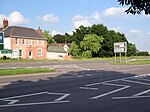Monks Kirby Rural District
Districts of England created by the Local Government Act 1894History of WarwickshireLocal government in WarwickshireRural districts of EnglandUse British English from August 2012 ... and 1 more
Warwickshire geography stubs
The Monks Kirby Rural District was a rural district of Warwickshire between 1894 and 1932, based on the part of the Lutterworth Rural Sanitary District which was in Warwickshire. Its council was based in the village of Monks Kirby. The district consisted of six civil parishes of Copston Magna Monks Kirby Pailton Stretton-under-Fosse Wibtoft WilleyDue to its small size (its population was recorded as 1,456 in 1931) the district was abolished in 1932 and merged into the Rugby Rural District, under the review caused by the Local Government Act 1929. The area is now part of the present borough of Rugby.
Excerpt from the Wikipedia article Monks Kirby Rural District (License: CC BY-SA 3.0, Authors).Monks Kirby Rural District
Geographical coordinates (GPS) Address Nearby Places Show on map
Geographical coordinates (GPS)
| Latitude | Longitude |
|---|---|
| N 52.45 ° | E -1.3 ° |
Address
Monks Kirby CP
England, United Kingdom
Open on Google Maps








